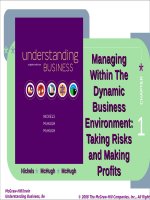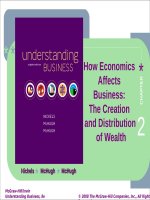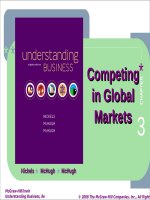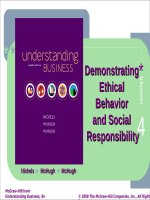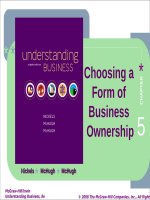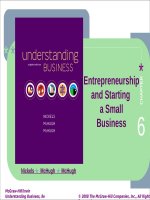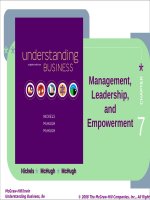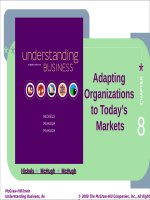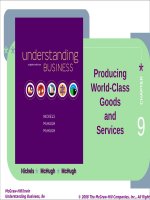Understanding business 11th by mchugh nickels CHAPTER 2
Bạn đang xem bản rút gọn của tài liệu. Xem và tải ngay bản đầy đủ của tài liệu tại đây (2.84 MB, 78 trang )
CHAPTER 2
Understandin
g Economics
and
How it Affects
Business
McGraw-Hill/Irwin
Copyright © 2015 by the McGraw-Hill Companies, Inc. All rights reserved.
MATT FLANNERY
Kiva
• Co-founder of Kiva.org and
helps people in developing
countries get small loans.
• Microlending has been a
source of funding in the
developing world since the
1980s.
• Came up with the idea while
working in rural Africa.
2-2
ECONOMICS…What Is It?
2-3
ECONOMICS…What Is It?
Economics -- The study of how society employs
resources to produce goods and services for
consumption among various groups and
individuals.
2-4
The MAJOR BRANCHES of
ECONOMICS
• Macroeconomics -- Concentrates on the operation
of a nation’s economy as a whole.
• Microeconomics -- Concentrates on the behavior
of people and organizations in markets for particular
products or services.
2-5
RESOURCE DEVELOPMENT
• Resource
Development -- The
study of how to
increase resources and
create conditions that
will make better use of
them.
2-6
Economic Theories
2-7
Economic Theories
Thomas Malthus
• “Dismal Science”
• Too many people
2-8
THOMAS MALTHUS and
the DISMAL SCIENCE
• Malthus believed that if the rich had most of
the wealth and the poor had most of the
population, resources would run out.
• This belief led the writer Thomas Carlyle to
call economics “The Dismal Science.”
• Neo-Malthusians believe there are too many
people in the world and believe the answer is
radical birth control.
2-9
Economic Theories
Adam Smith (1776)
• Advocated creating
• wealth through
• entrepreneurship
• Freedom is vital
• “Invisible Hand”
2-10
ADAM SMITH the
FATHER of ECONOMICS
Smith believed that:
• Freedom was vital to any
economy’s survival.
• Freedom to own land or
property and the right to
keep the profits of a
business is essential.
• People will work hard if
they believe they will be
rewarded.
2-11
The INVISIBLE HAND THEORY
• As people improve their own situation in life,
they help the economy prosper through the
production of goods, services and ideas.
• Invisible Hand -- When self-directed gain leads to
social and economic benefits for the whole
community.
2-12
UNDERSTANDING the
INVISIBLE HAND THEORY
LO 2-1
• A farmer earns money by selling
his crops.
• To earn more, the farmer hires
farmhands to produce more
crops.
• When the farmer produces more,
there is plenty of food for the
community.
• The farmer helped his
employees and his community
while helping himself.
2-13
TEST PREP
• What is the difference between macroeconomics
and microeconomics?
• What is better for an economy than teaching a
man to fish?
• What does Adam Smith’s term invisible hand
mean? How does the invisible hand create wealth
for a country?
2-15
Three Economic Systems
2-16
Three Economic Systems
Socialism
(Highly Controlled)
(Little Control)
Communism
Capitalism
2-17
Capitalism
2-18
CAPITALISM
• Capitalism -- All or most of the land, factories
and stores are owned by individuals, not the
government, and operated for profit.
• Countries with capitalist
foundations:
- United States
- England
- Australia
- Canada
2-19
STATE CAPITALISM
• State Capitalism -- When the state, rather than
private owners, run some businesses.
• Well-known countries practicing state
capitalism:
- China
- Russia
• These countries have experienced some success
using capitalistic principles, but the future is still
uncertain.
2-20
CAPITALISM’S
FOUR BASIC RIGHTS
1. The right to own private
property.
2. The right to own a business
and keep all that business’s
profits.
3. The right to freedom of
competition.
4. The right to freedom of choice.
2-21
FREE MARKETS
• Free Market -- Decisions about what and how
much to produce are made by the market.
• Consumers send signals about what they like
and how they like it.
• Price tells companies how much of a product
they should produce.
• If something is wanted but hard to get, the
price will rise until more products are
available.
2-22
Supply and Demand
2-23
Supply Curve
Supply -- The quantities of products businesses are
willing to sell at different prices.
High
Price(P)
S
Low
2-24
Quantity(S)
High
Demand Curve
• Demand -- The quantities of products consumers
are willing to buy at different prices.
High
Price(P)
D
Low
2-25
Quantity(D)
High
Equilibrium Point
• Market Price (Equilibrium Point) -- Determined
by supply and demand, this is the negotiated price.
Surplus
High
Market Equilibrium
Price
S
Low
2-26
Shortage
Quantity
D
High
